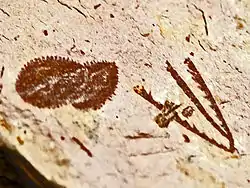| Phyllograptus Temporal range: Early Ordovician | |
|---|---|
 | |
| Phyllograptus species | |
| Scientific classification | |
| Kingdom: | |
| Phylum: | |
| Class: | |
| Order: | |
| Family: | Phyllograptidae |
| Genus: | Phyllograptus |
Phyllograptus is a graptolite genus of the order Graptoloidea, in the family Phyllograptidae.
Fossils of this genus have been found in the Early Ordovician (475-473 million years ago), in the sediments of Australia, Bolivia, Canada, Chile, China, New Zealand, Norway, Spain, Sweden, the United Kingdom and United States.[1]
The normal length of a colony of these leaf-shaped animals could reach a length of 3.5 centimetres (1.4 in). They were passively mobile planktonic suspension feeders.[1][2]
Phyllograptus species are excellent index fossils or guide fossils for identifying Ordovician rocks.[3]
Species
- Phyllograptus angustifolius
- Phyllograptus anna
- Phyllograptus densus
- Phyllograptus glossograptoides
- Phyllograptus rotundatus
References
- Cyril Walker & David Ward (1993) - Fossielen: Sesam Natuur Handboeken, Bosch & Keuning, Baarn. ISBN 90-246-4924-2
This article is issued from Wikipedia. The text is licensed under Creative Commons - Attribution - Sharealike. Additional terms may apply for the media files.